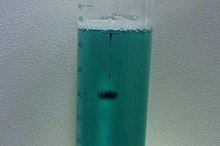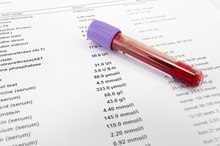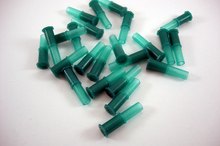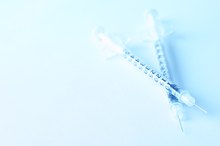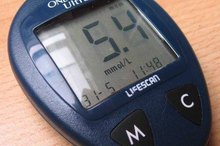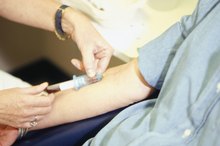What does fact checked mean?
At Healthfully, we strive to deliver objective content that is accurate and up-to-date. Our team periodically reviews articles in order to ensure content quality. The sources cited below consist of evidence from peer-reviewed journals, prominent medical organizations, academic associations, and government data.
The information contained on this site is for informational purposes only, and should not be used as a substitute for the advice of a professional health care provider. Please check with the appropriate physician regarding health questions and concerns. Although we strive to deliver accurate and up-to-date information, no guarantee to that effect is made.
How to Finger Prick to Check Iron Levels
Iron deficiency is the most common nutritional deficiency in the United States, according to the Centers for Disease Control. It is an especially common condition in children and women of childbearing age.Symptoms of iron deficiency include fatigue, headaches, dizziness, shortness of breath and pale skin. A small blood sample obtained through a finger prick test--also know as a hemoglobin test or Hgb--is all that is required to determine base iron levels. This test is always performed by a trained technician prior to donating blood. It is also performed by nurses or other trained individuals in most clinics and medical offices.
Wash hands with soap and warm water, paying special attention to areas that hide dirt and germs such as between fingers and under nails. Dry hands thoroughly with a clean cloth or paper towel.
How to Screen Blood Donor Hemoglobin using Copper Sulfate
Learn More
Put on a pair of disposable procedure gloves. With any medical procedure, it is important to maintain body substance isolation procedures by wearing gloves or other personal protective equipment mandated by protocols.
Select a finger to perform the test. Avoid using a finger that is calloused or injured in any way. Choose a bare finger since a ring could constrict circulation.
How to Measure Citric Acid in Fruits Simply
Learn More
Press on the selected finger with your gloved thumb. Begin at the knuckle and move to the tip of the finger using a rocking motion. This will help increase blood flow to the fingertip and produce a better sample.
Clean the test area with an alcohol wipe. Alcohol can dilute the sample, causing a false reading, so allow the finger to air dry before performing the finger prick.
Hold the finger with your gloved hand, using gentle pressure to support both the finger and the entire hand.
Use a lancet to make a small puncture on the side of the test finger. Blood should flow freely from the site. Discard the lancet in a sharps container.
Use a sterile gauze pad to wipe away the first drop of blood. The first drop of blood typically contains a high concentration of tissue fluid, which may cause a low reading.
Apply slight pressure to the distal--far end--of the finger to produce a large drop of blood. Avoid squeezing the finger near the puncture site as this will release more tissue fluid into the sample.
Place the tip of the collection device in the center of the blood drop. The blood will be drawn into the tube. To obtain a proper reading, the tube must be completely filled.
Wipe excess blood from the finger and the side of the collection device with gauze. Apply gentle pressure to the puncture site to stop the bleeding.
Inspect the collection device, looking for air bubbles within the sample. Discard the sample if there are air bubbles present in the middle of the sample. Bubbles toward the top of the sample should not affect the reading.
Insert the sample into the testing device or send it to the appropriate laboratory.
Discard any blood-contaminated items in a biohazard bag.
Related Articles
References
- Utah: Phlebotomy
- Van veenendaal LM, De klerk G, Van der velde D. A painful finger as first sign of a malignancy. Geriatr Orthop Surg Rehabil. 2014;5(1):18-20. doi:10.1177/2151458514522125
- Oetgen ME, Dodds SD. Non-operative treatment of common finger injuries. Curr Rev Musculoskelet Med. 2008;1(2):97-102. doi:10.1007/s12178-007-9014-z
- Prucz RB, Friedrich JB. Finger joint injuries. Clin Sports Med. 2015;34(1):99-116. doi:10.1016/j.csm.2014.09.002
- Christensen T, Sarfani S, Shin AY, Kakar S. Long-term outcomes of primary repair of chronic thumb ulnar collateral ligament injuries. Hand (N Y). 2016;11(3):303-309. doi:10.1177/1558944716628482
- Spies CK, Langer M, Hahn P, Müller LP, Unglaub F. The treatment of primary arthritis of the finger and thumb joint. Dtsch Arztebl Int. 2018;115(16):269-275. doi:10.3238/arztebl.2018.0269
- Deveza LA, Hunter DJ, Wajon A, et al. Efficacy of combined conservative therapies on clinical outcomes in patients with thumb base osteoarthritis: protocol for a randomised, controlled trial (COMBO). BMJ Open. 2017;7(1):e014498. doi:10.1136/bmjopen-2016-014498
- Makkouk AH, Oetgen ME, Swigart CR, Dodds SD. Trigger finger: etiology, evaluation, and treatment. Curr Rev Musculoskelet Med. 2008;1(2):92-6. doi:10.1007/s12178-007-9012-1
- Alla SR, Deal ND, Dempsey IJ. Current concepts: mallet finger. Hand (N Y). 2014;9(2):138-44. doi:10.1007/s11552-014-9609-y
Writer Bio
Amanda Goldfarb became a freelance writer in 2006. She has written many articles for "Oviedo TRI-Lights," "Cool Runnings" and several other health- and fitness-related blogs. She has also contributed to her town's tri-club newsletter. Goldfarb obtained her Bachelor of Arts degree in English from the University of Central Florida and is currently pursuing a degree in emergency medical services.
